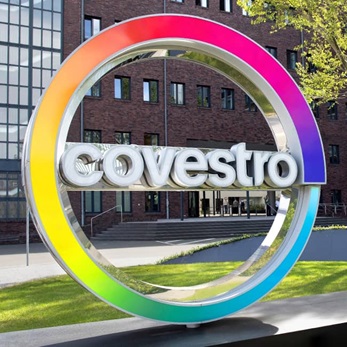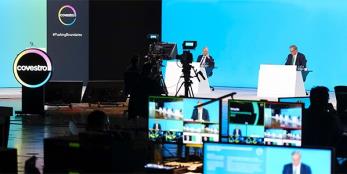Before working with this product, you must read and become familiar with the available information regarding its risks, proper use, and safe handling. This information is provided in various formats, including the current Safety Data Sheet (SDS) and product label. SDS can be accessed via the following link:
Safety Data Sheets (SDS) for Covestro products | Covestro
For further questions, please use the contact information provided on this technical data sheet.
Product description
Bayfol® HX120 is a light-sensitive, self-processing photopolymer film which can be used to manufacture reflection and transmission volume-phase holograms. Bayfol® HX120 film can be recorded with appropriate laser light within the spectral range of 440 nm to 680 nm and is optimized for the spectral range of 500 nm to 680 nm.Bayfol® HX120 film consists of a three layer stack of a substrate, the light-sensitive photopolymer and a protective cover film. A triacetate (TAC) substrate and a polyethylene terphthalate (PET) protective cover film are used.
Typical Values
Optical Properties
| Property | Test Condition | Value | Unit | Standard |
|---|---|---|---|---|
| Typical substrate thickness | 60 | microns | acc. to ISO 4593, 23°C | |
| Typical photopolymer thickness | 30 | microns | IR Interferometer | |
| Typical cover layer thickness | 50 | microns | acc. to ISO 4593, 23°C | |
| Typical recording dosage needed to achieve above ∆n1 values | See Annex graph 2, for details of the recording dosage | mJ/cm² | ||
| Light transmittance | (Unrecorded film, w/o cover foil) | See Annex graph 1, for details of the transmittance spectrum | % | ASTM E 01348 |
| Maximum refractive index modulation ∆n1 per recording wavelengt λ | acc. to ISO 17901-2 | |||
| λ = 633 nm | > 0,04 | |||
| λ = 532 nm | > 0,04 |
Storage
The unrecorded photopolymer film should be stored in the original and sealed Covestro packaging that is used for delivery. The unrecorded photopolymer film should be protected from light, humidity, heat , foreign materials and compressive load.Recommended storage temperature: +15 °C to +25 °C.Recommended relative humidity 45 % to 55 %
Storage time
Storage time 6 month.
Processing
Reflection Holograms in 2-Beam GeometryIn this recording geometry the photopolymer film is laminated onto a glass plate (75 mm x 50 mm x 1 mm). The holographic recording is done with two coherent and collimated laser beams (plane waves), which penetrate the prepared sample from its two different surfaces. Both laser beams have S-polarization to maximize the interference contrast (fringe visibility) of the holographic recording.The holographic recording itself is done with dosages which correspond to the product of the total incident power density (PR + PS) multiplied by the individual exposure times, t. More detailed conditions are depicted in the two following figures.The ratio (PS / PR) = 1.29 compensates for the different size of the projected beam cross sections onto the sample surfaces and the different losses due to Fresnel reflections at the air sample interfaces in such a way that inside the photopolymer layer the beam ratio is equal to 1. This again facilitates maximum fringe visibility during the holographic recording.After the holographic recording, the material is bleached using a dosage of approx. 5 J/cm² in the UV spectral range and simultaneously approx. 5 J/cm² in the visible spectral range.
To determine the performance of the hologram, the diffraction efficiency η of the recorded hologram is measured with respect to the rotation angle α (the holographic film / glass sandwich is mounted on a rotation stage). The resulting Bragg curve η(α) is analyzed according to the Kogelnik theory* , to deduce the performance parameters ηmax, Δn1 and the effective thickness shrinkage. The effective thickness shrinkage is obtained from the angular shift ε, which measures the deviation from the recording angle α to the angle at which ηmax is achieved. This thickness shrinkage is incorporated in the fit of Δn1 according to Kogelnik theory.The mean refractive index used for the calculation is 1.51.By varying the recording times the dosage response curves for Δn1 at the different recording wavelengths, λ = 633 nm, 532 nm and 457 nm, can be obtained. Source: *Kogelnik, H., "Coupled wave theory for thick hologram gratings", The Bell System Technical Journal 48(9), 2909-2947 (1969) Graph 1: Transmittance Graph 2: Index Modulation
Health and Safety Information
Disclaimer
Responsibility and Liability
The use of Covestro products, technical assistance, and information (regardless of how provided) is outside Covestro’s control and is solely the responsibility of the customer. The customer must conduct adequate testing to determine the suitability of products for its intended use, including but not limited to technical, health, safety, and environmental aspects. Unless otherwise agreed in writing, all products are sold exclusively under Covestro’s standard conditions of sale, which prevail in case of conflict and are available upon request.
The terms and conditions of sale and delivery are available via the following link:
https://order.covestro.com/covestrostorefront/saleConditions
All information is provided “as is” without warranties, express or implied, including merchantability or fitness for a particular purpose, and is subject to change without notice. To the maximum extent permitted by law, Covestro disclaims, and the customer assumes all liability for losses, damages, or claims arising out of use of Covestro products, technical assistance, or information. Any statement or recommendation not expressly contained in Covestro documentation is unauthorized and shall not bind Covestro. Nothing herein shall be construed as encouraging or recommending the use of any product in conflict with any claim of any patent. No license is implied or in fact granted under the claims of any patent.
Restrictions on Regulated Applications
This product is not intended for use in regulated applications such as agriculture, cosmetics, drinking water contact, food contact, medical products (e.g., medical devices), toys, or similar uses subject to specific regulatory requirements. Prior written approval from Covestro is required before this product may be used in any regulated application. The customer is solely responsible for ensuring compliance with all applicable laws and determining product suitability. Covestro disclaims all liability and warranties for unauthorized regulated uses.
Typical Value
These values are provided as typical data only and do not constitute binding specifications or warranted performance, unless explicitly agreed by Covestro in writing. Performance may vary depending on factors including, but not limited to, mold/die, processing conditions and coloring/pigmentation. Unless otherwise stated, values are based on standardized test specimens at room temperature.
Sample
Samples provided by Covestro are intended solely for evaluation and testing purposes by the customer and may not be used in commercial applications, resold, transferred to third parties (except qualified testing service providers acting on behalf of the customer), reverse engineered, modified, or used in any manner not explicitly authorized in writing by Covestro. Samples are provided ‘as-is’ without any warranties, express or implied, including fitness for a particular purpose. Customers are solely responsible for ensuring safe handling, regulatory compliance, and suitability of the material for their intended evaluations. Covestro disclaims all liability for damages or losses arising from the use of samples.
Contact Information
Please use our contact form or contact us directly by sending an e-mail to technical-datasheets@cx.covestro.com .







